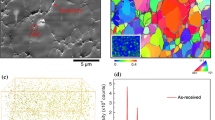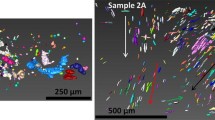Abstract
Internal fracture patterns developed in silicon carbide cylindrical targets as a result of dynamic indentation (63–500 m/s) by tungsten carbide spheres are defined. Microscopy of recovered and sectioned targets delineate into three regions, each associated with distinct cracking modes, i.e., shallow cone macrocracking at and near the impact surface, steep interior cone macrocracks that radiate into the target from the impact region and local grain-scale microcracking directly underneath the impact region. The observed fracture patterns are found to maintain a noticeable degree of self-similarity upto the impact velocity of 500 m/s. Linear elastic analysis of the full (surface and interior) stress field developed under static (Hertz) contact loading delineate the target into four regions, based on the number of principal stresses that are tensile (none, 1, 2 or all 3). A strong correlation is found between the principal stress conditions within each region and the forms of cracking, their locations and orientations present therein. This correlation has a number of implications, including non-interaction of crack systems, which are discussed. Illustrative linear elastic fracture mechanics analyses are performed for three regions, and calculated and observed macrocrack lengths are found to be in reasonable agreement.
Similar content being viewed by others
References
Barenblatt GI (1962). The mathematical theory of equilibrium cracks in brittle fracture. Adv Appl Mech 7: 55
Beissel SR, Johnson GR and Popelar CH (1998). An element-failure algorithm for dynamic crack propagation in general directions. Eng Fract Mech 61: 407–425
Benbow JJ (1960). Cone cracks in fused silica. Proc Phys Soc B75: 697–699
Chai H (2006). Crack propagation in glass coatings under expanding spherical contact. J Mech Phys Sol 54(3): 447–466
Espinosa HD, Brar NS, Yuan G, Xu Y and Arrieta V (2000). Enhanced ballistic performance of confined multi-layered ceramic targets against long rod penetrators through interface defeat. Int J Sol Struct 37(36): 4893–4913
Feenstra PH and De Borst R (1996). A composite plasticity model for concrete. Int J Sol Struct 33(5): 707–730
Fett T, Rizzi G and Diegele E (2004). Weight functions for cone cracks. Eng Fract Mech 71(16–17): 2551–2560
Fischer-Cripps AC (1997). Predicting Hertzian fracture. J Mat Sci 32: 1277–1285
Frank FC and Lawn BR (1967). On the theory of Hertzian fracture. Proc Roy Soc Lond A299: 291
Holmquist TJ and Johnson GR (2005). Characterization and evaluation of silicon carbide for high-velocity impact. J Appl Phys 97: 093502
Horii H and Nemat-Nasser S (1985). Compression-induced microcrack growth in brittle solids: axial splitting and shear failure. J Geophys Res 90(B4): 3105–3125
Huang C and Subhash G (2003). Influence of lateral confinement on dynamic damage evolution during uniaxial compressive response of brittle solids. J Mech Phys Sol 51(6): 1089–1105
Iyer KA, Swab JJ, LaSalvia JC (2006) Pre-penetration damage in silicon carbide resulting from sphere impact: characterization and analyses. In: Presented at 30th international conference on advanced ceramics and composites, Cocoa Beach, FL
Johnson KL (1985). Contact mechanics. Cambridge University Press, Cambridge
Johnson GR, Stryk RA, Holmquist TJ, Beissel SR (1997) Numerical algorithms in a lagrangian hydrocode. Technical report Wl-TR-1997-7039, Wright Laboratory, Eglin Air force Base
Johnson GR, Beissel SR and Stryk RA (2000). A generalized particle algorithm for high velocity impact computations. Comput Mech 25: 245–256
LaSalvia JC, Normandia MJ, Miller HT, MacKenzie DE (2005) Sphere impact induced damage in ceramics: I. Armor-grade SiC and TiB2. In: Swab JJ, Zhu D, Kriven WM (eds) Advances in ceramic armor. ISBN: 978-1-57498-237-4
Laturelle FG (1990). The stresses produced in an elastic half-space by a normal step loading over a circular area: analytical and numerical results. Wave Motion 12: 107–127
Lawn BR (1993). Fracture of brittle solids. Cambridge University Press, Cambridge
Lawn BR (1998). Indentation of ceramics with spheres: a century after Hertz. J Am Cer Soc 81(8): 1977–1994
Mouginot R and Maugis D (1985). Fracture indentation beneath flat and spherical punches. J Mat Sci 20: 4354–4376
Rajendran AM and Grove DJ (1996). Modeling the shock response of silicon carbide, boron carbide and titanium diboride. Int J Imp Eng 18(6): 611–631
Roesler F (1956). Brittle fracture near equilibrium. Proc Phys Soc B69: 981–992
Sun X and Khaleel MA (2004). Modeling of glass fracture damage using continuum damage mechanics - static spherical indentation. Int J Damage Mech 13(3): 263–285
Tabor D (1970). The hardness of solids. Rev Phys Technol 1: 145–179
Way S (1940). Some observations on the theory of contact pressures. J Appl Mech 62: 147–157
Wereszczak AA and Johanns KE (2006). Spherical indentation of SiC. Cer Eng Sci Proc 27(7): 43–57
Zeng K, Breder K and Rowcliffe DJ (1992). The Hertzian stress field and formation of cone cracks – I theoretical approach. Acta Metall Mater 40(10): 2595–2600
Author information
Authors and Affiliations
Corresponding author
Rights and permissions
About this article
Cite this article
Iyer, K.A. Relationships between multiaxial stress states and internal fracture patterns in sphere-impacted silicon carbide. Int J Fract 146, 1–18 (2007). https://doi.org/10.1007/s10704-007-9108-z
Received:
Accepted:
Published:
Issue Date:
DOI: https://doi.org/10.1007/s10704-007-9108-z




